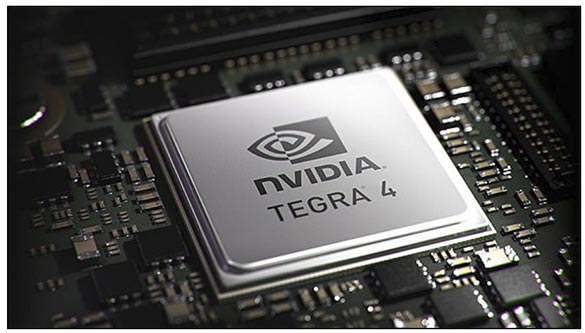NVIDIA SHIELD Tegra 4 Android Gaming Portable
NVIDIA SHIELD: Up Close
As we’ve mentioned, NVIDIA’s SHIELD is built around the company's homegrown Tegra 4 SoC. NVIDIA’s Tegra 4 builds upon the success of the Tegra 3 by incorporating updated quad ARM 15-based CPU cores with a custom 72-core GeForce GPU, which all told offers up to 6x the performance of Tegra 3.
Like its predecessor, Tegra 4 will also have a 4+1 CPU design, which combines 4 high-performance cores with a low-power battery saver core to prolong battery life (up to 14 hours of HD video playback on smartphones according to NVIDIA). The A15 cores used in Tegra 4, however, are up to 2.6x faster than the A9-class cores used in Tegra 3, for significantly better performance all around. The Tegra 4, which is clocked at up to 1.9GHz in SHIELD, is paired to 2GB of memory in SHIELD and 16GB of internal storage is present as well. The device also features built in 802.11n WiFi, Bluetooth 3.0, GPS, a 3-axis Gyro, and a 3-axis Accelerometer.
Wrapped around the Tegra 4 is a console-grade game controller, attached to a 5”, multi-touch display with a native resolution of 1280x720 (294 dpi). And in case you were wondering, the thing is built like a tank. The SHIELD feel very solid in the hand, though at about 579 grams, it is somewhat heavy. Regardless, if you had any concerns about SHIELD’s build quality after its initial delay, don’t—it’s exudes quality.
When closed, the NVIDIA SHIELD looks much like an Xbox controller, sans buttons (they’re hidden underneath the screen, obviously). The stock silver “tag” is positioned right on the back-side of the screen and there are “NVIDIA” and “SHIELD” badges, along with an air-vent, sandwiched right in between the handgrips at the front of the device.
There’s a lot more going on around the back of the SHIELD, however. Around back you’ll find a mini-HDMI output, a micro-USB charging / sync port, a headphone + microphone jack, a microSD card slot, and a relatively big exhaust vent. The Tegra 4 in SHIELD is actively cooled (air is pulled in through the front and exhausted out the back), though it is very quiet and never got particularly warm to the touch. On either side of all of those ports are some right and left trigger and shoulder buttons as well.
Flip up the screen, and SHIELD’s D-Pad and dual-analog joysticks are visible, along with some X/Y/A/B function buttons. Right about in the center of the device are five more buttons (volume, start, back, home, and NVIDIA). On either side of the buttons, you can also see SHIELD’s stereo speakers. The speakers are mounted in waveguides, with tuned ports and offer exceptionally good sound quality in our opinion, especially considering how small they are. We should also note, that just above center-mounted buttons, there is also a tiny microphone port.







